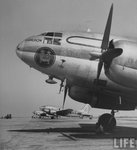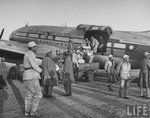The Republic of China Air Force (ROCAF) was formed by the Kuomintang after the establishment of the Aviation Ministry in 1920. As tensions mounted between China and Imperial Japan in the 1930s, a number of smaller Chinese warlord airforce men and equipment became integrated into the ROCAF in a centralized effort to counter Imperial Japanese military ambitions. During the Second Sino-Japanese War (1937–1945), the ROCAF participated in attacks on Japanese warships on the eastern front and along the Yangtze river including interdiction and close-air support for the Battle of Shanghai in 1937. Initially, the Chinese frontline fighter aircraft were mainly Curtiss Hawk IIs and IIIs and Boeing P-26Cs. These engaged Japanese fighters in many major air battles beginning on14 August 1937, when Imperial Japanese Navy warplanes raided Chienchiao airbase; "814" has thus become known as "Air Force Day". Chinese Boeing P-26/281 fighters engaged Japanese Mitsubishi A5M fighters in the world's first dogfight between all-metal monoplane fighters. A unique mission in April 1938 saw two Chinese Martin B-10 bombers fly a mission over Japan, but dropping only anti-war leaflets over the Japanese cities of Nagasaki and Saga. It was a war of attrition for the Chinese pilots, as many of their most experienced ace fighter pilots, such as Lieutenant Liu Tsui-Kang and Colonel Kao Chih-Hang, were lost. Six months into the war, which is considered the beginning of World War II in Asia, the Chinese Air Force inventory of frontline American Hawk IIs and IIIss and P-26Cs were superseded by faster and better armed Polikarpov I-15s and I-16s as support from the Soviet Union grew and American support faded.
Through attrition and loss of their most experienced fighter pilots in the first half of the Second Sino-Japanese War, the Republic of China Air Force ultimately suffered irreversible losses in combat against the Japanese, and by the beginning of 1942 the ROCAF was practically annihilated by Japanese aircraft, particularly with the introduction of the Mitsubishi A6M Zero. The ROCAF was eventually supplemented with the establishment of the American Volunteer Group (known as the "Flying Tigers") with heavily armed and armored Curtiss P-40 Warhawks, and subsequently rebuilt each year following Imperial Japan's attack on Pearl Harbor with new aid and vigor from the United States.
The Sino-Japanese War started on 7 July 1937. At that time, Chinese sources estimated the Japanese could field approximately 600 aircraft (from a total of 1,530) against China's 230 combat aircraft. During the first phase up to 1939, aerial bombing of enemy bomber formations was tried with indifferent results, and leaflet-dropping raids carried out over Japanese cities. The Japanese bombing raids were also fiercely contested, sometimes with significant Japanese losses. After suffering heavy losses in the Battle of Wuhan in October 1938, most air force units were withdrawn for reorganisation and training. The ROC Air Force was reconstituted into seven Groups, one separate Squadron and four Volunteer Groups. In 1940, the Russian Volunteer Group was stood down. By the end of 1941, the air force had 364 operational aircraft. Up to 100 of these were P-40Bs operated by the American Volunteer Group.[1] U.S. replacement aircraft began to arrive in March 1942. They included A-29s, P-40s, P-43s,[2] and P-66s, and in 1945 B-25s, B-17s, and P-51Bs and -Ds. In 1944, the USAAF U.S. 15th Air Force commenced joint operations in the China theatre.[citation needed] By this time the Chinese Air Force was mostly equipped with current operational aircraft types and was superior in all respects to the opposing Japanese air forces which remained.
Source: List of aircraft used in China before 1937 - Wikipedia, the free encyclopedia
Development of Chinese Nationalist air force (1937
Through attrition and loss of their most experienced fighter pilots in the first half of the Second Sino-Japanese War, the Republic of China Air Force ultimately suffered irreversible losses in combat against the Japanese, and by the beginning of 1942 the ROCAF was practically annihilated by Japanese aircraft, particularly with the introduction of the Mitsubishi A6M Zero. The ROCAF was eventually supplemented with the establishment of the American Volunteer Group (known as the "Flying Tigers") with heavily armed and armored Curtiss P-40 Warhawks, and subsequently rebuilt each year following Imperial Japan's attack on Pearl Harbor with new aid and vigor from the United States.
The Sino-Japanese War started on 7 July 1937. At that time, Chinese sources estimated the Japanese could field approximately 600 aircraft (from a total of 1,530) against China's 230 combat aircraft. During the first phase up to 1939, aerial bombing of enemy bomber formations was tried with indifferent results, and leaflet-dropping raids carried out over Japanese cities. The Japanese bombing raids were also fiercely contested, sometimes with significant Japanese losses. After suffering heavy losses in the Battle of Wuhan in October 1938, most air force units were withdrawn for reorganisation and training. The ROC Air Force was reconstituted into seven Groups, one separate Squadron and four Volunteer Groups. In 1940, the Russian Volunteer Group was stood down. By the end of 1941, the air force had 364 operational aircraft. Up to 100 of these were P-40Bs operated by the American Volunteer Group.[1] U.S. replacement aircraft began to arrive in March 1942. They included A-29s, P-40s, P-43s,[2] and P-66s, and in 1945 B-25s, B-17s, and P-51Bs and -Ds. In 1944, the USAAF U.S. 15th Air Force commenced joint operations in the China theatre.[citation needed] By this time the Chinese Air Force was mostly equipped with current operational aircraft types and was superior in all respects to the opposing Japanese air forces which remained.
Source: List of aircraft used in China before 1937 - Wikipedia, the free encyclopedia
Development of Chinese Nationalist air force (1937































